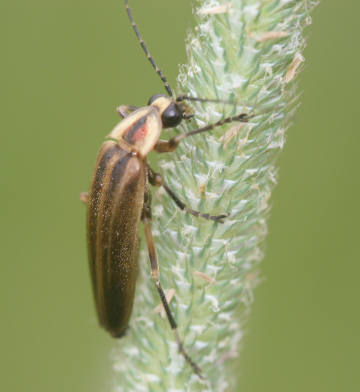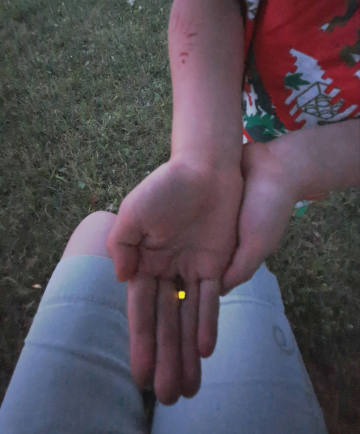Nature Notes

PHOTO COURTESY OF GARRY KESSLER
A firefly
June 9, 2024
NATURE NOTES
By Annie Reid
Westborough Community Land Trust
See local fireflies at dusk
In late June, as the time for July 4th fireworks approaches, you might catch a different light show – the flashing of fireflies. The show may even be in your own backyard. Fireflies are a fond summer memory for generations of New Englanders.
How can you see local fireflies this summer? Just plan to be outside in the right place and time. The last few days of June and the first two weeks of July are best. Go out at dusk, say from 8:45 pm to 9:30 pm. The right place could be your backyard (provided it has NOT been treated with pesticides or weed killers), or an “edge” area where woods meet a field or meadow. Or find someplace with moist soil and greenery, perhaps near water – a wetland, river, stream, pond, or vernal pool. Or check out a park or spot in your neighborhood, an Audubon sanctuary, a Mass Wildlife Management Area (WMA), state park, state forest, or national wildlife refuge. (Think of Westborough’s MacCallum WMA, Broad Meadow Brook Audubon in Worcester, Upton State Forest, or Assabet River National Wildlife Refuge.)
What’s the firefly flashing all about? If you’ve guessed courtship, you’re correct. Insect courtship? Yes, it’s real, even crucial. The flashing of fireflies – which are actually beetles (family Lampyridae, “shining fire”), NOT flies (order Diptera) – is their way of telling one species from another in the mating game, and of telling male from female.
The flash pattern is a kind of code. The number of flashes, the length of each flash, the amounts of time between them, and their sequence – all are important. And of course, the flashing happens on a time scale that fireflies perceive and appreciate. For example, a 1/2-second flash versus a 1/3-second flash versus a 1/10-second flash. Or a single flash versus a double flash. Or 2-3 seconds between flashes, versus 5 seconds, versus 3-8 seconds.
As the fireflies begin to come out, you might notice that they seem to rise up from the ground. They do. During the day and other times when they’re not out, they’re mostly in the soil or leaf litter. These beetles need warmth – air temperatures above 54 degrees F – and humidity to come out. They also need darkness, so turn out nearby lights.
Watching the firefly show as night falls, you might see that the flashes and the times between them are not always the same. Each species has its own flash pattern, and the males and females of each species have their own special patterns of flashing back and forth. The males fly and flash in the air. Females usually wait on the ground or in the greenery. Females tend to go for males of their own species with the brightest flashes. No flashing occurs during mating. Females lay eggs 2-6 days after mating. The eggs hatch into immature larvae about two weeks later.

PHOTO COURTESY OF Veronika Szentpétery-Kessler
A firefly in a child’s hand
Chances are you might see more than one species in a location. In other places, or at different times of night, the species might be different. Massachusetts has about 24 firefly species, out of 40 in New England and about 175 in North America. (Checklist: https://www.fireflyatlas.org/firefly-species/firefly-species-checklist). Around here you won’t see the famous synchronized flashing displays found in places such as Tennessee and North Carolina. There are more than 2,200 firefly species around the world.
How do these beetles make their light? They have a special “lantern” or light organ (photophore) in their back end. The lantern has three layers: a layer of transparent skin, a layer of light cells, and an inner layer that reflects light (like cats’ eyes). The light cells contain two chemicals (luciferin and luciferase). When triggered by a bit of energy (via ATP, the energy transfer molecule) and a flow of oxygen, the two combine (forming luciferyl) and release light (photons). This light is cold – not hot like old-fashioned light bulbs. Depending on the species, the light could be amber, yellowish, or greenish.
Adult fireflies live for only 2-3 weeks. Fireflies spend most of their lives on or under the ground as immature caterpillar-like larvae, hunting and eating snails, slugs, earthworms, and larvae of other beetles. In New England, most firefly larvae overwinter twice before transforming into adults.
If you’ve heard of “glowworms,” you might not be surprised that firefly larvae glow. So do tiny firefly eggs. This glowing (bioluminescence) takes place where we usually don’t see it, but it may serve to startle or warn off insect-eating predators such as birds, frogs, toads, bats, and more. The larvae contain bad-tasting, toxic chemicals that predators quickly learn to avoid.
The common fireflies in New England belong to three groups. The genus Photinus (meaning “light within”) contains the most species and the largest number of fireflies. Other common fireflies are in the genus Photuris (meaning “tail-light”) and the genus Pyractomena (meaning “fire producer”). There are also a few daytime species that do not flash light (in genera Ellychnia and Lucidota).
Can you tell who’s who in the light show? It’s not easy, but fun to try. Photinus species use yellowish, single flashes. Photuris species typically make greenish, double flashes (two quick ones). Pyractomena species make multiple amber flashes.
Some fireflies use flashes in devious ways. Some female Photuris fireflies actually entrap and eat male Photinus fireflies. How? These Photuris females imitate the flash patterns that Photinus females use to respond to Photinus males. When a half-inch Photinus male then approaches to check out the responding female, the much larger, inch-long Photuris female attacks and consumes him.
Like so many creatures, fireflies face many environmental threats these days. Light pollution, pesticides, development, habitat loss, and climate change all can make it harder for fireflies to thrive.
This year’s mild winter and wet spring should bring good conditions for fireflies. Go outside at dusk in late June and early July to enjoy the local firefly show. (Cover up to avoid mosquito bites.) And if kids want to try to catch fireflies, tell them it must be “catch and release”.
For more about fireflies, their conservation, and community science opportunities, see information from the Xerces Society (https://xerces.org/endangered-species/fireflies/about and https://xerces.org/endangered-species/fireflies/how-you-can-help).